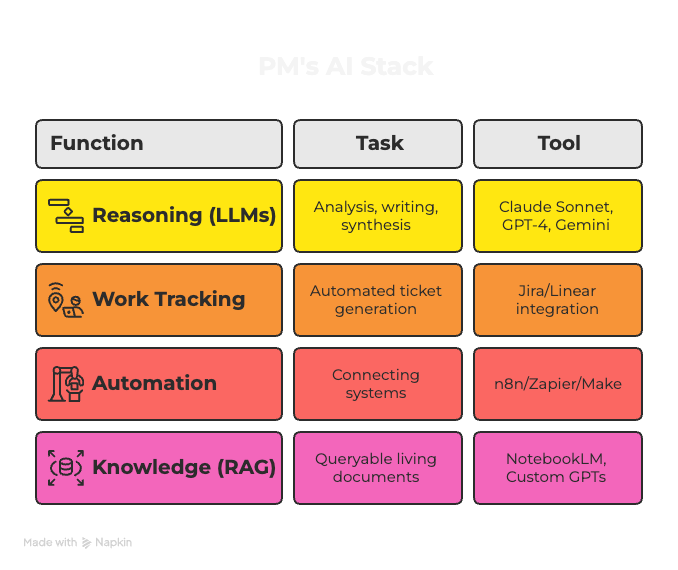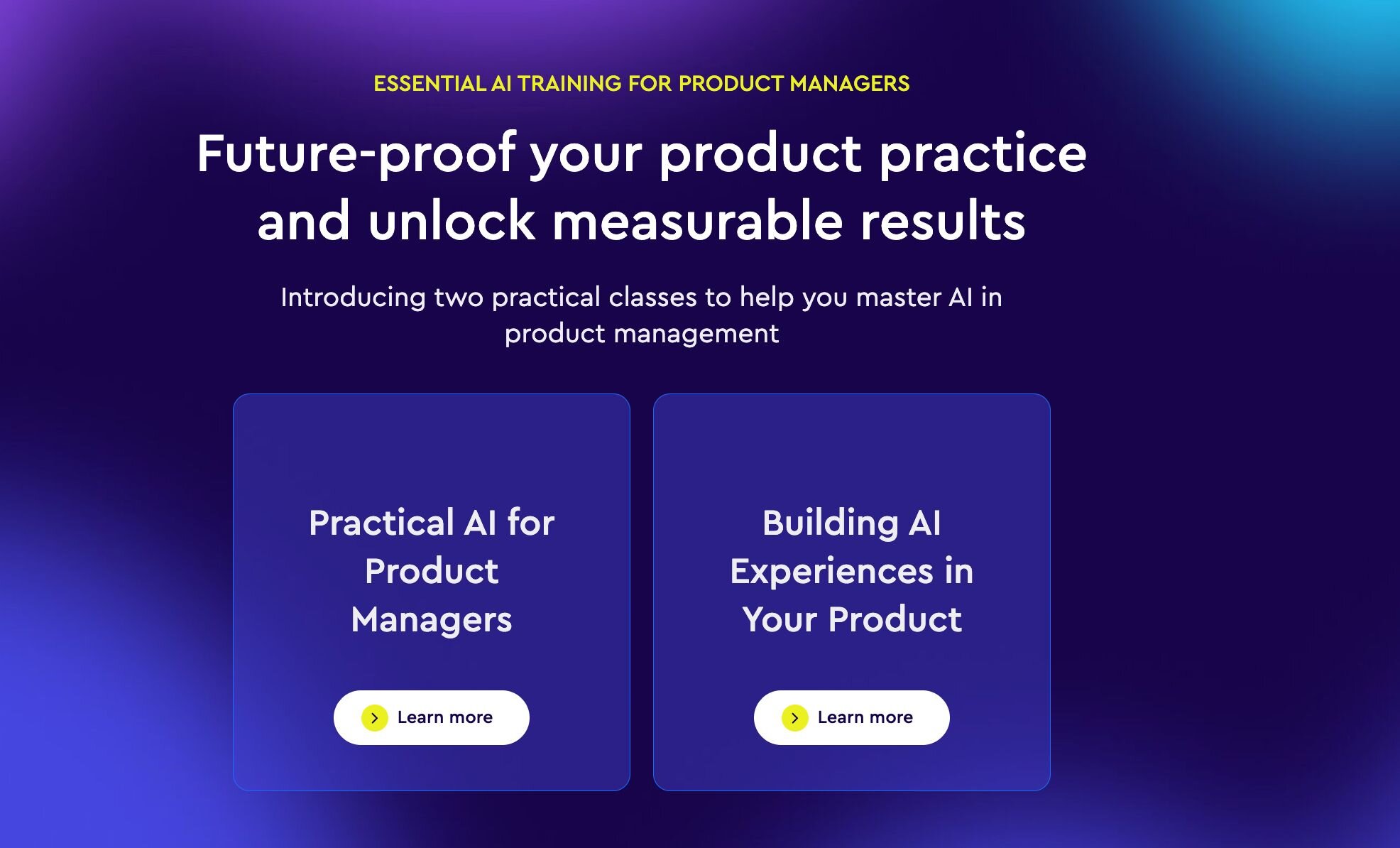AI is now the buzzword across every level of conversation, and it’s no surprise the UK government has recently laid out plans to integrate artificial intelligence nationwide to drive growth and streamline public services.
Their AI strategy, backed by major tech players, has reportedly secured £14 billion in funding for various initiatives, creating 13,250 jobs, according to BBC News. With such significant momentum, it feels like the perfect moment to dive into what’s happening among e-commerce leaders when it comes to embedding AI into their strategies
Do you know the key differences between Machine Learning and Generative AI?
As a product manager, I often work with machine learning (ML) and AI personalization, but I believe it’s important to highlight the difference between these two concepts. Machine learning focuses on analyzing existing data and making predictions, while generative AI is designed to create new content that mimics human creativity. For example, ML helps generate accurate forecasts or recommendations, whereas generative AI produces unique assets like personalized texts, images, or even videos.
The applications of these technologies also differ. ML is widely used in recommendation systems, dynamic pricing, and user behavior analysis. Generative AI, on the other hand, plays a crucial role in content creation, such as generating product descriptions or marketing visuals, which is particularly valuable in the e-commerce industry.
Despite their differences, ML and generative AI complement each other remarkably well. For instance, machine learning can enhance the performance of generative AI by providing more precise and structured training data. In return, generative AI can produce synthetic data, which is especially useful when real-world data is limited or too costly to obtain.
In the future, the combination of these technologies will be key to the evolution of e-commerce. Machine learning will continue to provide accuracy in analytics and predictions, while generative AI will push the boundaries of personalization by delivering creative and unique solutions for users. Together, they set the stage for the next wave of innovation in the industry, enabling scalable and efficient outcomes.
Comparative analysis. AI in products and services
The goal of my article is to analyze how e-commerce leaders are leveraging modern AI tools to identify key application patterns and apply these insights to my own work. Of course, every company operates within its unique landscape, with distinct resources and strategies, but it’s fascinating to uncover where industry leaders are focusing their efforts.
I closely observe how Amazon successfully leverages artificial intelligence to address key challenges in e-commerce. Based on insights from the company’s website, AI plays a critical role in personalizing customer experiences, optimizing supply chains, and managing warehouse operations. For instance, generative AI models create episode recaps for Prime Video, helping viewers refresh their memories without spoilers. **This feature has increased user engagement by 15% and reduced content abandonment rates by 10%**, as noted in Variety (2024). Additionally, demand forecasting systems powered by AI not only optimize inventory but also ensure timely deliveries, significantly enhancing the customer experience. **Amazon has reported a 20% improvement in inventory accuracy and a 25% reduction in overstock or understock scenarios** (Forbes, 2023). Additionally, demand forecasting systems powered by AI not only optimize inventory but also ensure timely deliveries, significantly enhancing the customer experience. Particularly noteworthy is Amazon’s use of AI in innovative projects like Amazon One, a contactless biometric identification system that simplifies payment and identity processes. These examples show how AI goes beyond data analysis to become the foundation for new products and improved customer interactions.
Alibaba’s AI-driven recommendation systems use vast datasets on consumer behavior to deliver real-time personalized suggestions. According to South China Morning Post (2023), this system has increased click-through rates by 38% and conversion rates by 25%. The system also analyzes user actions across multiple platforms, such as Taobao and Tmall, integrating data on clicks, purchases, cart additions, and search queries. One unique feature is the use of AI for audience segmentation and generating recommendations tailored to seasonal trends or local markets. For example, during major sales events, AI highlights products with the highest likelihood of purchase .
Shopify’s AI tools, such as Shopify Collabs, help small and medium-sized businesses utilize consumer behavior analytics to boost sales. As highlighted in TechRadar (2024), Shopify merchants using AI-powered marketing tools have seen a 22% increase in email campaign effectiveness and a 15% rise in overall sales. Shopify actively integrates AI for predictive analytics, studying customer behavior and recommending products based on past purchases. Moreover, AI is embedded into marketing tools, assisting merchants in creating personalized email campaigns and offers.
Comparison Table:
| Criterion | Amazon | Alibaba | Shopify |
| Focus | Personalization, supply chain optimization | Localization and seasonal recommendations | Support for small and medium-sized businesses |
| AI tools | Generative AI, demand forecasting | Big data analysis, audience segmentation | Predictive analytics, marketing integration |
| Unique features | Amazon One, Prime Video AI-based recommendations | Adaptation to local markets and seasonal trends | Personalized marketing campaign creation |
| Key business outcome | Improved convenience and purchase speed | Increased sales during seasonal peaks | Boost in sales for small and medium businesses |
Key patterns and differences
AI is actively employed by all three companies to personalize customer experiences and drive sales. However, the approaches and target audiences differ significantly. Amazon focuses on speed, convenience, and innovations like contactless identification. Alibaba emphasizes localization and seasonal trends, adapting to the unique demands of diverse markets. Shopify, on the other hand, aims to empower small businesses by providing AI-driven tools for crafting effective marketing strategies. These differences stem from the business models and primary objectives of each company.
After analyzing AI in recommendation systems, we can move on to the next examples.
AI in supply chain optimization – Walmart and Ocado
Walmart and Ocado showcase impressive examples of how AI can optimize supply chains, enhancing operational efficiency and customer satisfaction. Walmart leverages AI for inventory management, using predictive analytics to distribute goods between warehouses and stores based on seasonal demand—critical during holiday seasons. Walmart's AI-powered logistics tools optimize delivery routes, reduce costs, and minimize the carbon footprint. By implementing AI-driven route optimization, Walmart eliminated 30 million unnecessary miles, reducing CO₂ emissions by 94 million pounds. (Walmart, 2024) Additionally, AI-managed refrigerated warehouses analyze inventory almost instantaneously, improving warehouse productivity.
Ocado, on the other hand, focuses on automating its order fulfillment centers, where AI powers robotic systems for order assembly and packing. The Ocado Smart Platform (OSP) integrates AI for real-time data analysis, enabling it to adapt to demand fluctuations and optimize the entire supply chain. This technology has enabled Ocado to maintain a food waste rate of just 1 in 6,000 items, significantly lower than industry averages. (Forbes, 2024)
AI in сustomer service – H&M and Sephora
AI also plays a pivotal role in enhancing customer service. Since launching AI-driven customer service tools, H&M has reported a 30% decrease in response times and a 22% increase in customer satisfaction scores (Business Insider, 2024). Additionally, chatbot interactions account for 50% of customer queries, enabling human agents to focus on more complex cases and reducing overall support costs by 18% (Harvard Business Review, 2024). H&M employs chatbots and voice assistants to respond quickly to customer inquiries, helping them find products, check order details, and even receive style advice.
Sephora has taken automated support a step further, using AI-powered systems for personalization. Sephora's chatbots can recommend products based on customer preferences and offer makeup tips. These solutions not only improve service quality but also build customer loyalty (source). These AI-driven solutions have resulted in a 28% increase in conversion rates and a 15% improvement in customer retention (TechCrunch, 2024). Furthermore, Sephora's AI-powered personalization tools contribute to a 20% rise in average order value, as customers are more likely to purchase recommended products tailored to their needs (VentureBeat, 2023).
AI enhancing shopping experiences: Visual search and virtual try-ons (ASOS, IKEA)
AI is becoming a key tool for creating interactive and convenient shopping experiences. According to a 2023 report by Econsultancy, ASOS has seen a 35% increase in app engagement and a 20% rise in sales driven by visual search. This feature is particularly popular among younger shoppers, with 40% of users aged 18–24 utilizing it regularly (Wired, 2023). ASOS has implemented visual search technologies, allowing customers to upload images and find similar items in the company's catalog, simplifying the shopping process.
IKEA uses AI for virtual try-ons, enabling customers to upload photos of their spaces and place furniture virtually through augmented reality. A case study published by Retail Dive (2024), this technology has significantly improved the shopping experience, leading to a 25% reduction in product returns and a 15% increase in customer satisfaction. Moreover, the AR feature has boosted online sales by 18%, as customers feel more confident in their purchasing decisions (TechRadar, 2023). This technology makes shopping more engaging and convenient while reducing the risk of dissatisfaction with purchases (source).
Having gathered all the examples, I’m ready to present a comprehensive table for your review.
Table “AI applications across companies”
| Category | Amazon | Alibaba | Shopify | Walmart | Ocado | H&M | Sephora | ASOS | IKEA |
| AI in supply chain | AI-driven forecasting for inventory, supply chain automation (source). | AI manages large-scale logistics for supply chain efficiency. | No direct focus on supply chain optimization. | Predictive analytics for inventory, AI-optimized routes. | Robotic systems for order fulfillment (source). | N/A | N/A | N/A | N/A |
| AI in Recommendations | Advanced recommendation engine (personalized shopping experience). | AI-powered personalized recommendations (e.g., Taobao). | Tailored product suggestions and AI-driven marketing. | N/A | N/A | N/A | N/A | Visual search for similar items (source). | N/A |
| AI in Customer Service | Automated customer support, Alexa integrations for shopping assistance. | AI chatbots on Alibaba’s platforms. | Integrated chatbots for e-commerce stores. | N/A | N/A | Chatbots for inquiries and style tips. | AI-powered support for personalized product advice (source). | N/A | N/A |
| Enhanced Experiences | Personalized ads, visual search for products (source). | AR and VR for virtual shopping experiences. | N/A | N/A | N/A | N/A | N/A | Visual search technology (source). | Virtual try-ons for furniture (source). |
Key insights and business recommendations
Based on my analysis of AI applications across various e-commerce companies, several key insights emerge regarding the impact of artificial intelligence on key performance indicators such as conversion rates, customer satisfaction, and return on investment (ROI).
Conversion rates
AI-driven personalized shopping experiences, such as product recommendation systems, have been shown to significantly increase conversion rates. For example, product recommendations based on individual customer preferences can boost conversions by up to 35%. This highlights the power of AI in offering tailored suggestions, which not only enhances the user experience but also increases the likelihood of a purchase.
AI plays a crucial role in improving customer satisfaction as well. By integrating AI into search functionalities, companies can provide faster and more relevant results, improving the efficiency of the shopping process. This leads to a better overall user experience, which in turn drives higher customer retention and loyalty.
Return on investment (ROI)
Retailers using AI for customer segmentation have seen significant improvements in marketing ROI. For instance, AI-powered segmentation allows companies to achieve up to a 20% increase in ROI by enabling more accurate targeting and delivering highly personalized marketing campaigns that resonate with specific customer segments.
It’s important to note, however, that these outcomes can vary depending on the AI implementation strategies, technologies used, and the operational context of each company. For example, companies like Shopify, which are actively leveraging AI for personalized recommendations, continue to show impressive user engagement and positive performance metrics (Reuters). On the other hand, AI’s impact on fast fashion, as demonstrated by Shein’s transformation with AI (Time), shows both the potential and challenges associated with AI in this sector.
Landscape of e-commerce 2025-2028
Let's delve into the key AI trends shaping the e-commerce landscape today and explore the exciting possibilities that lie ahead.
As a product manager navigating the fast-paced world of e-commerce, I’ve seen AI evolve from a novel idea into a fundamental driver of innovation. AI-powered personalization is no longer optional; it’s the key to unlocking deeper customer connections, enhancing loyalty, and boosting revenue. Using insights from Deloitte, McKinsey, Gartner, and other leading organizations, I’ll also explore how these trends are expected to evolve by 2028 and what product managers need to do now to stay ahead.
AI personalization trends shaping e-commerce
1. Immersive shopping experiences with AR/VR
Augmented Reality (AR) and Virtual Reality (VR) are redefining how customers interact with products. For example, IKEA Place allows users to visualize how furniture fits in their space, while apps like Showoff enable users to virtually try on outfits they find on Google. Showoff's innovative approach not only empowers users to experiment with different styles but also establishes growth opportunities through partnerships with clothing brands, like its collaboration with a luxury offline retailer.
What does this mean for product managers?
Build AR/VR integrations into product pages, such as allowing customers to see how makeup shades look on their skin or how sneakers fit their feet. Sephora's Virtual Artist app is a great example of how AR elevates the cosmetic shopping experience.
- Explore partnerships with brands to showcase virtual try-ons and drive collaborative growth, similar to Showoff’s strategy with luxury brands.
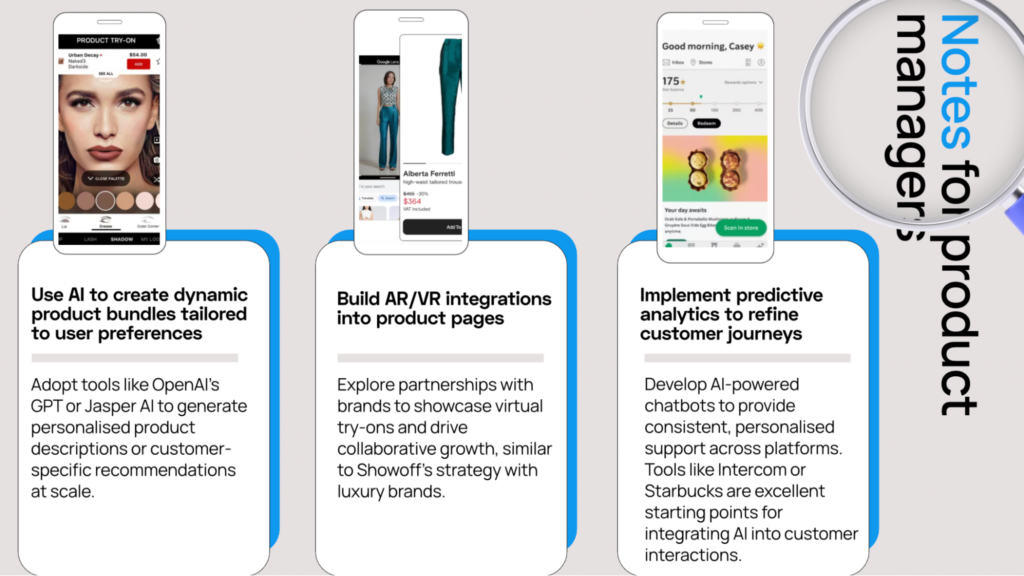
2. Hyper-personalization with generative AI
Generative AI goes beyond simple recommendations by creating unique, tailored experiences. For instance, Spotify uses AI to curate hyper-personalised playlists for users based on their listening habits. Similarly, Amazon's “Buy It Again” feature anticipates users’ needs by highlighting frequently purchased products.
What does this mean for product managers?
Use AI to create dynamic product bundles tailored to user preferences. For example, a sports retailer could recommend a “workout essentials pack” based on a customer’s past purchases, like gym shoes, leggings, and water bottles.
- Adopt tools like OpenAI’s GPT or Jasper AI to generate personalised product descriptions or customer-specific recommendations at scale.
3. AI-Powered customer journey orchestration
AI excels at unifying data from multiple touchpoints to create seamless, omnichannel customer journeys. A great example is Starbucks, which uses AI to send personalized offers based on a customer’s order history, preferences, and even weather conditions. A Gartner study predicts that by 2025, a significant majority of retailers – a remarkable 80% – will have integrated AI to enhance customer experience and streamline operations. (Source: Gartner)
What does this mean for product managers?
Implement predictive analytics to refine customer journeys. For instance, an online grocery store could send reminders for recurring purchases like milk or bread before customers run out, or recommend recipes based on what’s in their cart.
- Develop AI-powered chatbots to provide consistent, personalized support across platforms. Tools like Intercom or Drift are excellent starting points for integrating AI into customer interactions.
Trend Forecasts for 2025–2028
NUMBER 1. AI-Powered personal shopping assistants
In the coming years, personal shopping assistants will evolve to curate highly tailored product selections and guide customers through the buying journey in real-time. For example, AI-powered tools like Google Shopping already personalize recommendations by tracking user behavior.
Practical Example Create a virtual personal stylist in your app that provides outfit suggestions based on customer preferences, recent purchases, and social media trends.
- Leverage customer data to offer unique shopping experiences, such as gifting recommendations for special occasions or wardrobe updates based on the season.
NUMBER 2. Emotion Recognition for Enhanced Interactions
Emotion recognition technology will transform customer interactions by analyzing facial expressions, tone of voice, and even text sentiment to deliver more empathetic support. For instance, H&M is testing AI-powered mirrors in stores that analyze facial expressions to recommend clothing styles.
Practical Example
Use emotion recognition to adapt chatbot responses in real time. A travel booking platform, for example, could detect frustration in a user’s tone and prioritize connecting them to a live agent.
- Integrate sentiment analysis tools into customer service platforms like Zendesk to enhance interaction quality.
NUMBER 3. Predictive replenishment and subscription models
AI-driven subscription services will become a mainstay of e-commerce, with platforms like Amazon and Chewy leading the way. By analyzing past behavior, these services anticipate customers’ needs and automate reordering for maximum convenience. The impact is undeniable: a McKinsey report found that companies leveraging AI-powered personalization can expect a significant boost in revenue, often exceeding 15%. (Source: McKinsey & Company)
Practical Example
A beauty brand could launch a subscription service that predicts when customers will run out of products like skincare or shampoo and automatically ships replacements.
- Combine predictive analytics with loyalty programs to offer exclusive discounts on replenishments, encouraging long-term brand engagement.
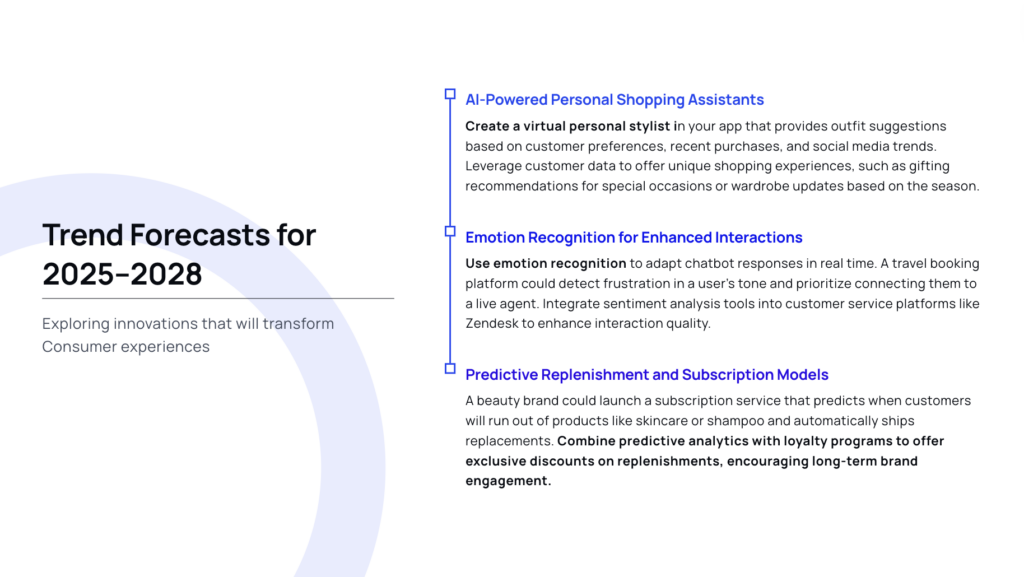
Actionable recommendations for product managers
Well then, let me dare to offer some recommendations that will laser-focus your efforts on AI-powered personalisation tools. These aren't just quick fixes for short-term customer journey challenges—they're game-changers that can directly impact your OKRs and drive meaningful progress toward your company’s broader business objectives.
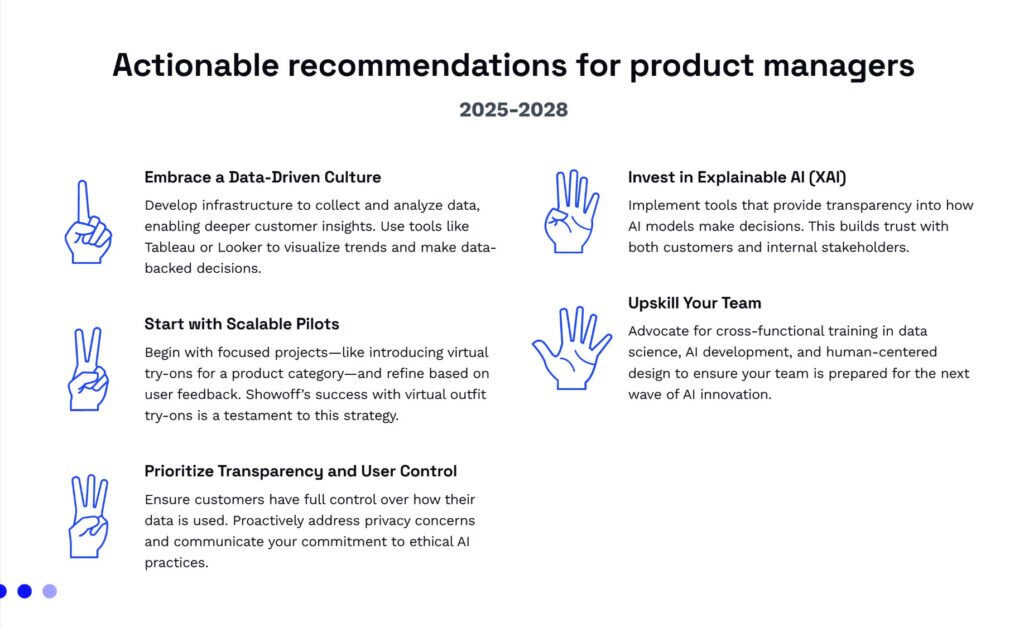
- Embrace a data-driven culture: Develop infrastructure to collect and analyze data, enabling deeper customer insights. Use tools like Tableau or Looker to visualize trends and make data-backed decisions.
- Start with scalable pilots: Begin with focused projects—like introducing virtual try-ons for a product category—and refine based on user feedback. Showoff’s success with virtual outfit try-ons is a testament to this strategy.
- Prioritize transparency and user control: Ensure customers have full control over how their data is used. Proactively address privacy concerns and communicate your commitment to ethical AI practices.
- Invest in explainable AI (XAI): Implement tools that provide transparency into how AI models make decisions. This builds trust with both customers and internal stakeholders.
- Upskill your team: Advocate for cross-functional training in data science, AI development, and human-centered design to ensure your team is prepared for the next wave of AI innovation.
The future of e-commerce belongs to those who leverage AI to create deeply personalized, memorable experiences. By embracing these trends, product managers can not only meet customer expectations but also redefine them.
Now is the time to innovate, lead, and deliver the next generation of e-commerce experiences. Let’s build the future, one personalized interaction at a time.





